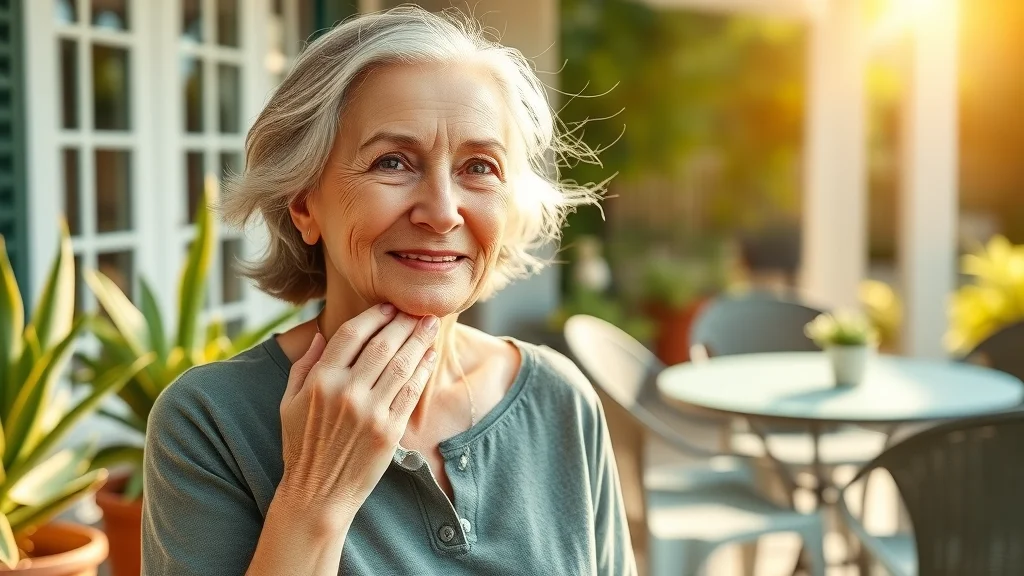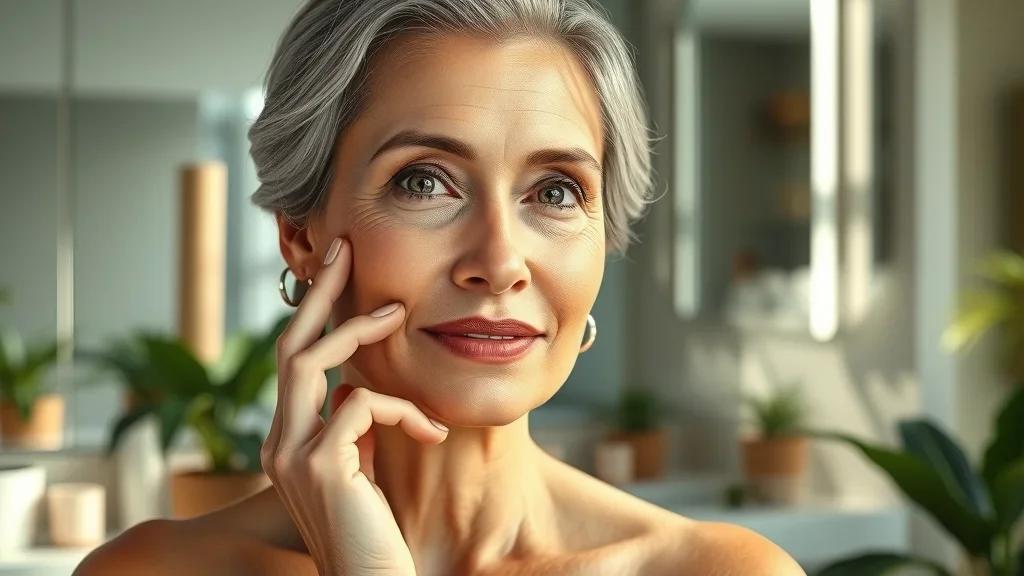Did you know women can lose up to 30% of their skin’s collagen just within the first five years of menopause? That’s a jaw-dropping revelation that highlights the vital—yet often overlooked—role hormones, especially estrogen, play in how our skin ages. If you want to preserve youthful skin and protect yourself from premature aging, understanding the estrogen link could be the game-changer you need. This comprehensive guide will reveal the science behind skin aging, spotlight estrogen’s essential function, and provide actionable strategies to help you maintain healthier, younger-looking skin for years to come.
Skin Aging: Unveiling the Estrogen Link
Skin aging isn’t just a matter of adding candles to your birthday cake. Scientific research now shows that hormonal fluctuations—particularly the decline in estrogen—have a profound impact on skin age, texture, and resilience. Estrogen helps maintain skin thickness, moisture, and elasticity, making its loss a significant trigger for premature aging. As estrogen levels drop, especially after menopause, the skin becomes more prone to dryness, sagging, age spots, and even skin tags, making the days of youthful radiance feel like a distant memory.
The link between skin aging and estrogen is not merely cosmetic—it’s biological. Estrogen interacts with the cell cycle, influences collagen production, and protects skin cells from free radical and DNA damage. In older adults, this protective shield weakens with declining estrogen, accelerating both visible and structural skin changes. Recognizing this connection empowers you to choose effective prevention strategies, support overall hormonal health, and reduce the risk of complications like skin cancer. Whether you’re noticing early signs of skin ageing or want expert strategies to slow down the process, this article equips you with the knowledge to take proactive control of your skin’s future.

A Surprising Statistic: How Estrogen Impacts Skin Age
“Recent studies reveal that women lose up to 30% of their skin’s collagen within the first five years of menopause—a process dramatically influenced by declining estrogen levels.”
This statistic emphasizes how significant the hormone’s decline is in the accelerated loss of skin structure and elasticity. Collagen loss not only alters skin texture and firmness but also marks one of the earliest biological changes linked to rapid skin age during hormonal shifts in older adults. Experts now urge increased attention to hormonal balance as a vital component in slowing the progression of both normal and premature aging.
What You’ll Learn About Skin Aging and Estrogen
How estrogen influences the biology of skin aging
Differences between skin ageing and premature aging
The role of free radicals, skin cell cycle, and estrogen
Practical strategies to slow down premature aging
Expert insights on reversing signs of skin age
The Science of Skin Aging

Skin Ageing: Biological Foundations
At its core, skin aging is a combination of internal and external processes involving everything from genetics and hormonal changes to sun exposure and free radical damage. The natural cell cycle slows with age—leading to reduced skin renewal, diminished elasticity, and increased visible changes such as fine lines and dry skin. Estrogen plays a pivotal role in maintaining this delicate balance by supporting stem cell growth, enhancing skin hydration, and combating free radical stress. As skin cells experience more DNA damage and cell death, the aging process accelerates, leading not just to cosmetic changes, but also to weakened protection against irritants, potential carcinogens, and environmental stressors.
Understanding these foundations helps explain why older adults may notice a sudden surge in age spots, skin tags, and persistent dry skin during menopause or periods of hormonal imbalance. Hormonal health and the biology of the cell cycle are fundamentally intertwined—meaning that disruptions in estrogen levels can manifest as structural and visible changes long before deep wrinkles or sagging set in. Proactively addressing hormonal fluctuations and supporting cellular resilience is crucial for healthier skin ageing and reducing the risk of complications like skin cancer in older people.
Understanding Skin Change and the Cell Cycle
The skin’s appearance and function are deeply rooted in the cell cycle—a coordinated dance of stem cells renewing, repairing, and shedding old skin. When estrogen is abundant, this process is efficient: new skin cells form regularly, hydration is maintained, and collagen synthesis keeps skin smooth. As estrogen declines, the cell cycle slows, skin cell death increases, and the ability to recover from DNA damage diminishes, resulting in the visible signs of aging skin such as fine lines, dullness, and lack of resilience. Targeting this cellular rhythm is key for both prevention and intervention in the premature aging process.
Environmental Factors: The Role of Free Radicals in Skin Aging
Environmental stressors, most notably sun exposure and pollution, introduce free radicals—unstable molecules that damage skin DNA and accelerate cellular senescence. Estrogen acts as a protective buffer against some of this free radical damage by strengthening lipid barriers and boosting natural antioxidants. When estrogen levels dip, skin becomes more vulnerable, making older adults particularly susceptible to oxidative damage. Over time, this not only exacerbates visible aging signs—such as age spots and dry skin—but can also increase the risk for more serious problems, including various forms of skin cancer like basal cell carcinoma and squamous cell carcinoma.
Key Biological Markers of Skin Ageing vs. Chronological Age | |||
Biological Marker |
Role in Skin Aging |
Chronological Change |
Accelerated Change (Estrogen Loss/Premature Aging) |
|---|---|---|---|
Collagen Content |
Firmness, Structure |
Gradually declines |
Sharp decrease post-menopause |
Elasticity |
Suppleness, Resilience |
Slowly decreases |
Rapid loss during hormonal shifts |
Skin Hydration |
Plumpness, Comfort |
Low decrease with age |
Significant reduction with estrogen decline |
Cell Renewal Rate |
Skin Texture, Radiance |
Gradual slowing |
Dramatic slowdown in older adults |
Free Radical Resistance |
Defense vs. DNA Damage |
Adequate in youth |
Compromised with premature aging |
What Accelerates Premature Aging?
Premature aging isn’t simply an unlucky roll of the genetic dice; it’s the result of modifiable and non-modifiable risk factors, all of which interact with hormonal status—especially with estrogen. Sun exposure tops the list, with UV rays causing cumulative DNA damage and triggering free radical formation that hastens collagen loss and increases risks like skin cancer—including basal cell and squamous cell carcinoma. Poor nutrition, particularly in older adults, also reduces the pool of antioxidants and building blocks needed for cell cycle progression and skin repair.
Finally, hormonal fluctuations—whether from menopause, medications, or underlying health conditions—bidirectionally amplify premature skin ageing. As estrogen wanes, the skin’s defense against environmental threats, dehydration, and cell death weakens, setting the stage for earlier and more pronounced appearance changes, from age spots to persistent dry skin. By understanding and addressing these drivers, both intrinsic and extrinsic, individuals and their care teams can slow skin aging and maintain vibrant, resilient skin throughout life’s stages.
Sun exposure and the link to skin cancer
The impact of nutrition on older adults’ skin
Role of hormonal fluctuations, specifically estrogen
Estrogen’s Role in Skin Structure and Function
How Estrogen Affects Collagen and Elasticity

Estrogen profoundly shapes the integrity of our skin—it supports collagen production, boosts skin elasticity, and preserves the skin’s natural ability to retain moisture. Collagen forms the backbone of firmness and structural smoothness, while elasticity ensures that the skin rebounds from pressure, stretching, and daily movements. When estrogen levels are robust, the skin looks plump and smooth, wrinkles are minimal, and age spots are less likely to appear.
With declining estrogen, especially during the shift into menopause or hormonal disruption, the skin’s collagen network quickly unravels. This leads to more visible fine lines, sagging, and a dull complexion. Additionally, the loss of elasticity isn’t merely cosmetic. It compromises the skin’s defense mechanisms, leaving it more susceptible to external irritants and impeding efficient wound healing in older adults. Supporting estrogen balance or mimicking its effects through targeted skincare can help counteract these changes and slow skin ageing, giving mature skin a more youthful and resilient appearance.
Estrogen Decline: Effects on Dry Skin, Age Spots, and Skin Tags
“Estrogen is not just a reproductive hormone; its presence in the skin is vital for maintaining hydration, texture, and resilience.”
When estrogen diminishes, dry skin becomes one of the first and most pronounced changes—moisture retention drops, leading to irritation, flaking, and discomfort. This is compounded by the appearance of age spots and skin tags, early indicators of disrupted cell cycles and compounding environmental stresses. Age spots signal areas where pigment production becomes uneven due to both intrinsic aging and long-term exposure to DNA-damaging factors like UV rays.
Skin tags, meanwhile, arise from disturbances in cellular turnover—a process tightly controlled, in part, by estrogen. For older adults, these changes not only affect appearance but also increase the risk of complications like skin infections. Tackling estrogen decline through both lifestyle adjustments and targeted therapies can help restore skin moisture, provide a smoother texture, and limit the onset of age-related skin changes, helping women (and men) maintain healthier aging skin for longer.
Signs of Skin Aging: From Fine Lines to Age Spots
Early indicators of premature aging
Differences in skin changes across older adults vs. younger individuals
Recognizing advanced signs like skin tags and persistent dryness
Visible Changes in Skin With Age – Timeline by Skin Age | ||
Skin Age |
Common Changes |
Notable Signs |
|---|---|---|
20s |
Even skin tone, good elasticity |
Rare fine lines, healthy glow |
30s |
Slight dryness, occasional dark spots |
First fine lines, subtle dullness |
40s |
Increased fine lines, less firm |
Noticeable dryness, visible age spots |
50s+ |
Prominent wrinkles, sagging, thinness |
Persistent dryness, skin tags, pronounced age spots |

Hormonal Shifts and Premature Aging in Women
The Menopause-Skin Connection: Effects on Cell Cycle and Skin Age

Menopause marks one of the most critical periods in a woman’s skin aging journey, with plunging estrogen levels abruptly slowing down the cell cycle. The result? Reduced skin renewal, increased cell death, and heightened vulnerability to DNA damage. As older adult women progress through menopause, they often experience rapid onset of fine lines, age spots, and dry skin, all hallmarks of interrupted hormonal balance and altered cell cycle regulation. These changes make it essential to recognize menopausal status as a key driver of both intrinsic and premature aging, above and beyond external factors alone.
Medical professionals now recommend hormone assessments and personalized interventions for women entering menopause. By supporting hormonal health—through nutrition, supplementation, or medical therapies—the negative impacts on skin age can be mitigated, and resilience can be restored. Open discussions with your physician about hormonal shifts, skincare, and protective strategies are invaluable, ensuring you’re equipped to navigate these life stage transitions with confidence and proactivity.
Free Radical Damage During Estrogen Decline
One of the dual challenges during menopause and estrogen decline is the spike in free radical damage. Without adequate estrogen, the skin’s lipid and antioxidant defenses weaken, leaving skin cells unprotected and speeding the cellular aging process. Free radicals directly attack collagen and elastin fibers—leading to more rapid structural breakdown and advancing the appearance of fine lines, age spots, and even skin cancer in predisposed individuals. This risk underlines the importance of sun protection and antioxidant-rich care for older adults at every life stage.
Targeted use of topical and dietary antioxidants, along with estrogen-supportive therapies, can buffer the effects of oxidative stress and DNA damage, helping you protect your skin throughout hormonal transitions. Proactive management of free radical exposure, from sunscreen to diet, becomes even more critical for preventing premature aging and safeguarding long-term skin health, especially for those with a family history of skin cancer or accelerated skin ageing.
Expert Strategies to Slow Down Skin Aging

Top Recommendations to Prevent Premature Aging
Sun protection and reduction of free radical exposure: Daily use of sunscreen, protective clothing, and avoidance of peak sun hours dramatically lowers the risk of skin cancer and slows DNA damage that drives premature aging.
Hormone health—nourishing the body pre- and post-menopause: Regular hormonal evaluation and support (including potential estrogen therapy under physician guidance) can mitigate rapid collagen loss, dry skin, and sagging.
Nutrition and lifestyle adjustments for older adults: Diets rich in antioxidants (e.g., vitamin C, E, polyphenols from fruits and vegetables) and healthy fats are essential to fortify skin’s natural defenses, support the cell cycle, and maintain youthful structure and function.
Experts agree: simple lifestyle choices made today can yield profound benefits for your skin age tomorrow. By focusing on proactive prevention—rather than reactive correction—anyone can slow skin changes, minimize risks, and maintain confidence throughout every stage of life.
Skin Aging and Treatment: Can You Reverse Skin Age?

Evidence-Based Approaches for Anti-Aging
Modern dermatology offers a robust toolkit for addressing skin aging. Evidence-based approaches include regular use of topical retinoids and antioxidants, professional interventions (such as laser therapy and microneedling), and supporting skin structure from within with bioactive nutritional supplements. These modalities have all demonstrated meaningful improvements in clinical trials, especially when combined with hormonal management and sun protection.
For women experiencing estrogen decline, additional options include estrogen therapy (topical or systemic), always under a doctor’s supervision. Hormonal support can slow collagen loss, improve dry skin, and bolster natural resilience. Recent research confirms that while we can’t entirely reverse skin age, we can absolutely shift the visible and functional outcomes in a positive direction, especially when evidence guides the way.
Estrogen Therapy and Its Impact on Skin Aging
“While we cannot turn back chronological time, interventions targeting estrogen’s role in skin often yield remarkable improvements in skin age and appearance.”
Estrogen therapy carries both promise and responsibility: it is highly effective in restoring skin density, smoothing fine lines, and managing persistent dryness or age spots. However, these therapies aren’t suitable for everyone, and expert consultation is essential. When appropriate, estrogen therapy can complement traditional anti-aging regimens, providing a more comprehensive defense against both the immediate and long-term impacts of skin aging, especially in postmenopausal women.
Exploring all options—from lifestyle and topical treatments to medical interventions—empowers individuals to protect their skin, maximize health, and extend the timeline of youthful skin beyond what was once thought possible.
People Also Ask: Answers to Common Skin Aging Questions
What is the main cause of skin aging?
Skin aging is primarily caused by a combination of genetic, environmental (such as UV and free radical damage), and hormonal factors, including declines in estrogen.
How can I stop my skin from aging?
Preventing skin aging involves sun protection, maintaining hormonal health, healthy nutrition, avoiding smoking, and using evidence-based skincare.

At what age does skin start aging?
Skin aging typically begins around the mid-20s, but accelerates during menopause due to declining estrogen, especially in women.
Can you reverse aging on skin?
While complete reversal of skin aging is impossible, targeted interventions including hormone therapy, antioxidants, and professional skincare can significantly improve skin age.
Skin Aging FAQs
How does estrogen influence skin moisture compared to other hormones?
What are the best routines for minimizing skin aging in older adults?
Does skin cancer risk increase with skin age or premature aging?
Key Takeaways: Safeguarding Your Skin Age Against Premature Aging
Skin aging is multifactorial but estrogen plays a pivotal role—especially for women
Premature aging can be minimized with proactive hormonal and lifestyle care
The earlier you implement skin-protective strategies, the stronger your defense against visible signs of aging
Take the First Step: Assess Your Skin Age and Begin Your Journey to Healthier, Younger-Looking Skin
Your skin’s future is in your hands. Start today—consult a dermatologist, consider a hormonal health checkup, and adopt a daily skincare routine that protects, nourishes, and restores. The journey to lasting radiance and healthy skin age begins now!
 Add Row
Add Row  Add
Add 




Write A Comment